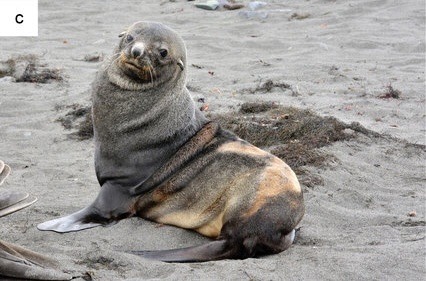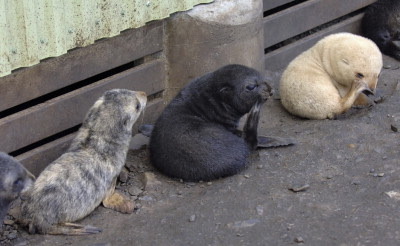Let’s Swim With Mama

let’s swim with mama
More Posts from Fursealfan and Others
potato chip’s old man groan…
via


Aerial photos of J-pod socialising
Photos by SR3/SEA (source)
this picture is so beautiful to me, the colours brothers

Animal welfare advocacy should be about the animals, not an agenda

J62!!!
source: center for whale research

"Eavesdropping on whale songs over the last six years is providing new information vital to answering questions about these giants of the ocean.
The number of whale songs detected is associated with shifting food sources, according to the California scientists—and the number of days humpbacks have been singing has nearly doubled.
When monitoring baleen whale songs in the Pacific Ocean, researchers found year-to-year variations correlated with changes in the availability of the species they forage on.
In vast oceans, monitoring populations of large marine animals can be a “major challenge” for ecologists, explained Dr. John Ryan, a biological oceanographer at the Monterey Bay Aquarium Research Institute in California (MBARI).
Their team deployed underwater microphones called hydrophones to study and track baleen whales, which communicate over long distances through sound.
“Surprisingly, the acoustic behavior of baleen whales provides insights about which species can better adapt to changing ocean conditions,” said Dr. Ryan, a lead author of the study.
They also monitored songs from blue, fin, and humpback whales off the West Coast of the U.S. to see what the song data could reveal about the health of their ecosystem.
The findings, published in the journal PLOS One, showed “large” year-to-year variations in whale song detection.
“The amount of humpback whale song continually increased, with their songs being detected on 34% of days at the beginning of the study and rising to 76% of days after six years,” said Dr. Ryan.
“These increases consistently tracked improved foraging conditions for humpback whales across all study years—large increases in krill abundance, followed by large increases in anchovy abundance.
“In contrast, blue and fin whale song rose primarily during the years of increasing krill abundance.
“This distinction of humpback whales is consistent with their ability to switch between dominant prey. An analysis of skin biopsy samples confirmed that changes had occurred in the whales’ diets.”
He explained that other factors, including the local abundance of whales, may have contributed to patterns in song detections observed in some years, but changes in foraging conditions were the most consistent factor.
“Overall, the study indicates that seasonal and annual changes in the amount of baleen whale song detected may mirror shifts in the local food web.”
WHALES ON THE COMEBACK TRAIL: • Gray Whale, Extinct for Centuries in Atlantic, Is Spotted in Cape Cod • Sighting of Many Blue Whales Around Seychelles is First in Decades – ‘Phenomenal’ • Majestic Sei Whales Reappear in Argentine Waters After Nearly a Century
“The results suggest that an understanding of the relationship between whale song detection and food availability may help researchers to interpret future hydrophone data, both for scientific research and whale management efforts”, which could better protect endangered species."
-via Good News Network, March 1, 2025
Begging you for some pinnipeds any pinnipeds please
Piebald Northern fur seal

Atypical colored Antarctic fur seal! With the orange, white, and grey they look calico.

Leucistic Antarctic fur seal

Interesting gang of Antarctic fur seal, one is leucistic and one almost looks brindle?

Leucistic southern elephant seal

Northern fur seal labeled as albino and partial albino (leucistic?) by some sources. NOAA says albino and they are experts.

Albino harbor seal

Albino ringed seal

Melanistic grey seal

Japanese Sea Lion
Gone before we could truly know them.
Zalophus japonicus memorial • extinct

Last confirmed sighting 1951
Declared extinct by ICUN 1994.
Originally considered a subspecies of Californian sea lions, later were confirmed to be a separate species in 2003.
Extinction due to over hunting & habitat destruction.
The Japanese sea lion was a species of pinniped found in the western North Pacific, including Japan and the Korean Peninsula. They typically resided on open beaches, and occasionally in rocky areas. They also often would rest in caves.
Rare footage of Japanese Sea Lions
Japanese sea lions were victims of both over hunting and habitat destruction. They were primarily hunted for oil, with other parts being used for medicine and other goods. The commercial harvest of them is considered to be a primary factor in their extinction.
Habitat destruction, particularly destruction brought on by WW2 submarines is also believed to have played a role in their extinction.
Along with the Caribbean Monk Seal, these two make up the only pinnipeds to go extinct in modern times.

lets lean on a pipe with mama (x)
-
 nachosandnecromancy reblogged this · 2 weeks ago
nachosandnecromancy reblogged this · 2 weeks ago -
 libbysankey liked this · 2 weeks ago
libbysankey liked this · 2 weeks ago -
 tryingtowriteplease liked this · 2 weeks ago
tryingtowriteplease liked this · 2 weeks ago -
 wanderingpanacea liked this · 2 weeks ago
wanderingpanacea liked this · 2 weeks ago -
 heartofmachinaisms reblogged this · 2 weeks ago
heartofmachinaisms reblogged this · 2 weeks ago -
 heartofmachinaisms liked this · 2 weeks ago
heartofmachinaisms liked this · 2 weeks ago -
 maureenkpliskin liked this · 3 weeks ago
maureenkpliskin liked this · 3 weeks ago -
 servonium reblogged this · 3 weeks ago
servonium reblogged this · 3 weeks ago -
 ace-and-the-rpg-horrors reblogged this · 3 weeks ago
ace-and-the-rpg-horrors reblogged this · 3 weeks ago -
 live-laugh-obsess reblogged this · 3 weeks ago
live-laugh-obsess reblogged this · 3 weeks ago -
 am00eba reblogged this · 3 weeks ago
am00eba reblogged this · 3 weeks ago -
 allez-argeiphontes liked this · 3 weeks ago
allez-argeiphontes liked this · 3 weeks ago -
 f4gb0yz20 liked this · 3 weeks ago
f4gb0yz20 liked this · 3 weeks ago -
 elecctromechanika liked this · 3 weeks ago
elecctromechanika liked this · 3 weeks ago -
 bell-swamp-fitzjames reblogged this · 3 weeks ago
bell-swamp-fitzjames reblogged this · 3 weeks ago -
 denisglillie reblogged this · 3 weeks ago
denisglillie reblogged this · 3 weeks ago -
 denisglillie liked this · 3 weeks ago
denisglillie liked this · 3 weeks ago -
 iz-hands reblogged this · 3 weeks ago
iz-hands reblogged this · 3 weeks ago -
 cleaverqueer liked this · 3 weeks ago
cleaverqueer liked this · 3 weeks ago -
 flemmboyant liked this · 3 weeks ago
flemmboyant liked this · 3 weeks ago -
 femboypussy420 reblogged this · 3 weeks ago
femboypussy420 reblogged this · 3 weeks ago -
 toph-proudfoot reblogged this · 3 weeks ago
toph-proudfoot reblogged this · 3 weeks ago -
 merenbee reblogged this · 3 weeks ago
merenbee reblogged this · 3 weeks ago -
 toph-proudfoot liked this · 3 weeks ago
toph-proudfoot liked this · 3 weeks ago -
 cheap-lemons-and-theatrics liked this · 3 weeks ago
cheap-lemons-and-theatrics liked this · 3 weeks ago -
 thatdapperdragon liked this · 3 weeks ago
thatdapperdragon liked this · 3 weeks ago -
 m0rumotto liked this · 3 weeks ago
m0rumotto liked this · 3 weeks ago -
 gh0ulsh4rk liked this · 3 weeks ago
gh0ulsh4rk liked this · 3 weeks ago -
 2-kamikou-1 liked this · 3 weeks ago
2-kamikou-1 liked this · 3 weeks ago -
 angry-druids-anonymous reblogged this · 3 weeks ago
angry-druids-anonymous reblogged this · 3 weeks ago -
 butterflyslayer44 liked this · 3 weeks ago
butterflyslayer44 liked this · 3 weeks ago -
 indubitably-moi liked this · 3 weeks ago
indubitably-moi liked this · 3 weeks ago -
 54321dcba reblogged this · 3 weeks ago
54321dcba reblogged this · 3 weeks ago -
 sufiblackmamba reblogged this · 3 weeks ago
sufiblackmamba reblogged this · 3 weeks ago -
 sufiblackmamba liked this · 3 weeks ago
sufiblackmamba liked this · 3 weeks ago -
 ace-and-the-rpg-horrors reblogged this · 3 weeks ago
ace-and-the-rpg-horrors reblogged this · 3 weeks ago -
 wingednerdmaker liked this · 3 weeks ago
wingednerdmaker liked this · 3 weeks ago -
 devilsrecreation liked this · 3 weeks ago
devilsrecreation liked this · 3 weeks ago -
 haronettereiher liked this · 3 weeks ago
haronettereiher liked this · 3 weeks ago -
 deltarunegirl liked this · 3 weeks ago
deltarunegirl liked this · 3 weeks ago -
 wait-no-why liked this · 3 weeks ago
wait-no-why liked this · 3 weeks ago -
 odysseusandorpheus liked this · 3 weeks ago
odysseusandorpheus liked this · 3 weeks ago -
 badcyka liked this · 3 weeks ago
badcyka liked this · 3 weeks ago -
 binturongism liked this · 3 weeks ago
binturongism liked this · 3 weeks ago -
 lavender-wren reblogged this · 3 weeks ago
lavender-wren reblogged this · 3 weeks ago -
 lavender-wren liked this · 3 weeks ago
lavender-wren liked this · 3 weeks ago -
 bununiii reblogged this · 3 weeks ago
bununiii reblogged this · 3 weeks ago -
 bununiii liked this · 3 weeks ago
bununiii liked this · 3 weeks ago -
 amarenacherriezzz reblogged this · 4 weeks ago
amarenacherriezzz reblogged this · 4 weeks ago

